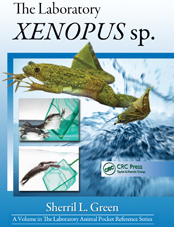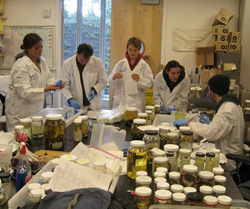
Xenopus are a major, non-mammalian laboratory animal model. They are a hardy, long-lived and fully aquatic amphibian species. Under laboratory conditions, they can lay eggs year around, thus providing researchers with a steady supply of biological material. Xenopus are used to study vertebrate embryology, cellular biology, biomedical-physiology, toxicology and biochemistry. My research focuses on the biology, health and disease of laboratory Xenopus. Stanford undergraduates and veterinary residents participate in Xenopus research projects on topics ranging from infectious disease, parasitology, husbandry and housing, to animal welfare and behavior. More »
Personnel

Sherril Green, DVM, PhD
Professor and Chair
(650) 498-5080
Edwards
(650) 498-5085 (fax)
Andrea Cowen (Class 2011)
Sabrina Wilson (Class of 2011)
Erica Morgan (Class of 2011)
Examining archived Xenopus specimens at the California Academy of Sciences. Pictured from left to right: Stanford Undergraduate Andrea Cowen ('11), Dr. Stephen Felt (Assistant Professor, Department of Comparative Medicine), Erica Morgan ('11), Sabrina Wilson ('11) and Sam McNally (graduate student, Vredenburg Lab, SFSU)
Publications


